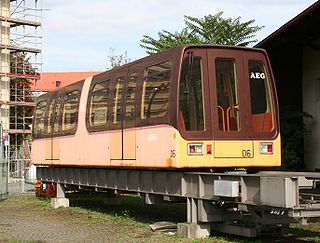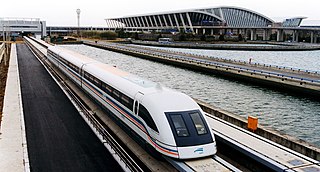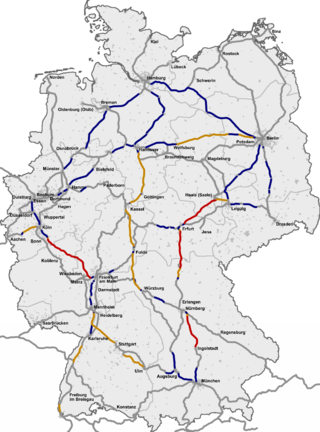Landkreis Emsland is a district in Lower Saxony, Germany named after the river Ems. It is bounded by the districts of Leer, Cloppenburg and Osnabrück, the state of North Rhine-Westphalia, the district of Bentheim in Lower Saxony, and the Netherlands.

Transrapid is a German-developed high-speed monorail train using magnetic levitation. Planning for the Transrapid system started in 1969 with a test facility for the system in Emsland, Germany completed in 1987. In 1991, technical readiness for application was approved by the Deutsche Bundesbahn in cooperation with renowned universities.

Maglev is a system of train transportation that is levitated along a guideway through the use of magnetic forces. By levitating, maglev trains remove the rail-to-wheel contact present in conventional railways, eliminating rolling resistance.

The M-Bahn or Magnetbahn was an elevated Maglev train line operating in Berlin, Germany, experimentally from 1984 and in passenger operation from 1989 to 1991. The line was 1.6 kilometres (1 mi) in length, and featured three stations, two of which were newly constructed. Presumed to be the future of rail transit in Berlin, the line was built to fill a gap in the West Berlin public transport network created by the construction of the Berlin Wall. It was rendered redundant by the reunification of Berlin and was closed to enable reconstruction of the U2 line.

The Shanghai maglev train (SMT) or Shanghai Transrapid is a magnetic levitation train (maglev) line that operates in Shanghai, China. The line uses the German Transrapid technology. The Shanghai maglev is the world's first commercial high-speed maglev and has a maximum cruising speed of 300 km/h (186 mph). Prior to May 2021 the cruising speed was 431 km/h (268 mph), at the time this made it the fastest train service in commercial operation.

Electromagnetic suspension (EMS) is the magnetic levitation of an object achieved by constantly altering the strength of a magnetic field produced by electromagnets using a feedback loop. In most cases the levitation effect is mostly due to permanent magnets as they don't have any power dissipation, with electromagnets only used to stabilize the effect.
A vactrain is a proposed design for very-high-speed rail transportation. It is a maglev line using partly evacuated tubes or tunnels. Reduced air resistance could permit vactrains to travel at very high (hypersonic) speeds with relatively little power—up to 6,400–8,000 km/h (4,000–5,000 mph). This is 5–6 times the speed of sound in Earth's atmosphere at sea level.

The Intercity Experimental, later renamed ICE V, was an experimental train developed by the Deutsche Bundesbahn for research into high-speed rail in Germany. It is the predecessor of all Intercity Express trains of the Deutsche Bahn.
On 22 September 2006, a Transrapid magnetic levitation train collided with a maintenance vehicle near Lathen, Germany, killing 23 people and wounding 11. It was the first fatal accident involving a maglev train.

UK Ultraspeed was a proposed high-speed magnetic-levitation train line between London and Glasgow, linking 16 stations including Edinburgh, Birmingham, Manchester and Newcastle and six airports. It was rejected in 2007 by the UK government, in favour of conventional high-speed rail. The company behind the proposal ceased efforts to promote it in early 2013.

Construction of the first high-speed rail in Germany began shortly after that of the French LGVs. However, legal battles caused significant delays, so that the German Intercity-Express (ICE) trains were deployed ten years after the TGV network was established. Germany has around 1,658 kilometers of high speed lines.

Lähden is a municipality in the Emsland district, in Lower Saxony, Germany.

Lathen is a municipality in the Emsland district, in Lower Saxony, Germany. It is the location of the Emsland Transrapid Test facility, a testing site for Transrapid maglev trains.
Siemens Mobility is a division of Siemens. With its global headquarters in Munich, Siemens Mobility has four core business units: Mobility Management, dedicated to rail technology and intelligent traffic systems, Railway Electrification, Rolling Stock, and Customer Services.
Lathen is a railway station located in Lathen, Lower Saxony, Germany. The station lies on the Emsland Railway and the train services are operated by WestfalenBahn. Lathen is also the location of the Transrapid Maglev train track.

Hyperloop is a proposed high-speed transportation system for both public and goods transport. The idea was picked up by Elon Musk and SpaceX engineers as a means to disrupt a proposed California High-Speed Rail system and described as a transportation project involving capsules supported by air-bearings in low-pressure environment inside a tube. Hyperloop systems have three essential elements: tubes, pods, and terminals. The tube is a large, sealed low-pressure system. The pod is a coach pressurized at atmospheric pressure that experiences low air resistance or friction inside this tube using magnetic propulsion. The terminal handles pod arrivals and departures. The Hyperloop, in the initial form proposed by Musk, differs from vactrains by relying on residual air pressure inside the tube to provide lift by aerofoils and propulsion by fans; however, many subsequent variants using the name "Hyperloop" have been relatively traditional vactrains.

Transport System Bögl (TSB) is a maglev system for driverless trains developed by the German construction company Max Bögl since 2010. Its primary intended use is for short to medium distances and speeds up to 150 kilometres per hour (93 mph) for uses such as airport shuttles. The company has been doing test runs on an 820 metres (2,690 ft) long test track at their headquarters in Sengenthal, Upper Palatinate, Germany since 2012 clocking over 100,000 tests covering a distance of over 65,000 kilometres (40,000 mi) as of 2018.
The CRRC 600 is a high-speed magnetic levitation (maglev) train under development in China, using German Transrapid technology under license from Thysenkrupp. The first trainset was unveiled in July 2021 at the CRRC Qingdao Sifang factory in Qingdao. The train is planned to reach 600km/h, which would make it one of the fastest trains in the world.











